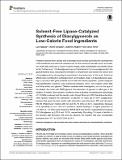Por favor, use este identificador para citar o enlazar a este item:
http://hdl.handle.net/10261/150079COMPARTIR / EXPORTAR:
 SHARE SHARE
 CORE
BASE CORE
BASE
|
|
| Visualizar otros formatos: MARC | Dublin Core | RDF | ORE | MODS | METS | DIDL | DATACITE | |

| Título: | Solvent-free lipase-catalyzed synthesis of diacylgycerols as low-calorie food ingredients |
Autor: | Vázquez de Frutos, Luis CSIC ORCID ; González, Noemí; Reglero, Guillermo CSIC ORCID ; Torres, Carlos F. CSIC ORCID | Palabras clave: | Solvent-free Transesterification Medium-chain fatty acid Lipase Diacylglycerol Fatty acid ethyl esters |
Fecha de publicación: | 2016 | Editor: | Frontiers Media | Citación: | Frontiers in Bioengineering and Biotechnology 4: 6 (2016) | Resumen: | Problems derived from obesity and overweight have recently promoted the development of fat substitutes and other low-calorie foods. On the one hand, fats with short- and medium-chain fatty acids are a source of quick energy, easily hydrolyzable and hardly stored as fat. Furthermore, 1,3-diacylglycerols are not hydrolyzed to 2-monoacylglycerols in the gastrointestinal tract, reducing the formation of chylomicron and lowers the serum level of triacylglycerols by decreasing its resynthesis in the enterocyte. In this work, these two effects were combined to synthesize short- and medium-chain 1,3-diacylglycerols, leading to a product with great potential as for their low-calorie properties. Lipase-catalyzed transesterification reactions were performed between short- and medium-chain fatty acid ethyl esters and glycerol. Different variables were investigated, such as the type of biocatalyst, the molar ratio FAEE:glycerol, the adsorption of glycerol on silica gel, or the addition of lecithin. Best reaction conditions were evaluated considering the percentage of 1,3-DAG produced and the reaction rate. Except Novozym 435 (Candida antarctica), other lipases required the adsorption of glycerol on silica gel to form acylglycerols. Lipases that gave the best results with adsorption were Novozym 435 and Lipozyme RM IM (Rhizomucor miehei) with 52 and 60.7% DAG at 32h, respectively. Because of its specificity for sn-1 and sn-3 positions, lipases leading to a higher proportion of 1,3-DAG vs. 1,2-DAG were Lipozyme RM IM (39.8 and 20.9%, respectively) and Lipase PLG (Alcaligenes sp.) (35.9 and 19.3%, respectively). By adding 1% (w/w) of lecithin to the reaction with Novozym 435 and raw glycerol, the reaction rate was considerably increased from 41.7 to 52.8% DAG at 24h. | Versión del editor: | https://doi.org/10.3389/fbioe.2016.00006 | URI: | http://hdl.handle.net/10261/150079 | DOI: | 10.3389/fbioe.2016.00006 | Identificadores: | doi: 10.3389/fbioe.2016.00006 issn: 2296-4185 |
| Aparece en las colecciones: | (CIAL) Artículos |
Ficheros en este ítem:
| Fichero | Descripción | Tamaño | Formato | |
|---|---|---|---|---|
| lowcalorie.pdf | 2,43 MB | Adobe PDF |  Visualizar/Abrir |
CORE Recommender
PubMed Central
Citations
3
checked on 27-mar-2024
SCOPUSTM
Citations
20
checked on 15-abr-2024
WEB OF SCIENCETM
Citations
18
checked on 26-feb-2024
Page view(s)
270
checked on 22-abr-2024
Download(s)
154
checked on 22-abr-2024

